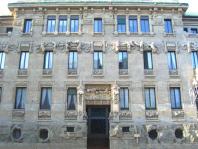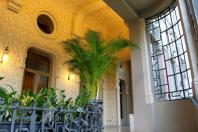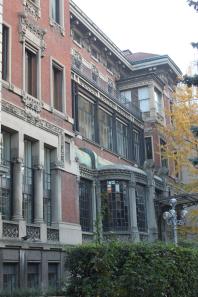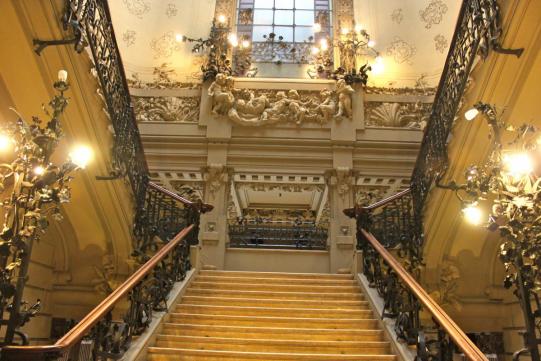Palazzo Castiglioni’s History
Characteristics

Palazzo Castiglioni, was built by Giuseppe Sommaruga (1867-1917) from 1901-1904, and represents a manifestation of the Art Nouveau style in Milan. The building was created with three floors, and with two façades (the main facade opens onto the street while the secondary one gives onto the garden), plus the annexes are detached from the main building, thus making up the stables and the storage.
This building has a rough rusticated stone basement that evokes the natural rocky forms; the decorations are inspired by 18th century Stucco building. It currently houses the Unione Commercianti di Milano (Unione del commercio – Confcommercio).
Palazzo’s history
In 1900, the industrialist Ermenegildo Castiglioni decided to build himself a palace built in Corso Venezia. The building, had to be different from all the others, and this was the reason why he hired the architect Giuseppe Sommaruga, who was famous for his unconventional solutions.
His attitude, was if he were a seventeenth-century nobleman who wanted to show off his own wealth and grandeur, and can be perceived throughout the palace (it is particularly impressive if compared to the Italian Liberty style) as well as in his desire to realize a building in a rather new, for Italy, architectural style (the Liberty style, indeed) as well as in a context of the most “noble” people of the city, by almost assuming an attitude of defiance to the conformist and conservative fellow citizens.
He probably lost this challenge because in 1903 they removed the scaffolding from the façade; moreover, the public opinion stood against him, and made him remove two female statues erected above the entrance gate. The two statues, created by Ernesto Bazzaro, caused so much turmoil that the local newspaper Guerin Meschino published a series of satirical illustrations on them in the months that followed Palazzo Castiglioni’s inauguration (March 17-24-31, June 11-14 and July 19). The female figures’ symbolic meaning turned out to be incomprehensible (even if they were intended to represent peace and industry) and, consequently, they were criticized because they did not have any precise function: these were not caryatids to support the gate or the balcony and, finally, (this was exactly the main problem) they were accused of being too provocative and naked. Milanese common people started to ironically call the palace “Cà di ciapp”, that in Milanese means “House of buttocks”.
The two statues were subsequently removed and furthermore put on the side of the Villa Luigi Faccanoni in Milan. The gate without these two important elements needed to be modified: it was raised to occupy a part of the upper window, which was then closed by a bas-relief. The end result was to remove strength to the central element of the building, in other words, to the gate and to the group of the main floor windows above it, that now turns out to have the same emphasis of the service side gate enriched above with a beautiful tripartite window.
Milanese Liberty: Palazzo Castiglioni
 Palazzo Castiglioni, which was designed by Giuseppe Sommaruga and inaugurated in May 1903, is the first strictly Liberty style building in the city, although, curiously or provocatively, it is located right in the heart of Corso Venezia, the noble street of Milan since the eighteenth century, and characterised by its Neoclassical simplicity. Thus, for many reasons, the effect is striking: monumental dimensions, austere façade and nostalgic homage to Michelangelo in the use of rustication and the abundance of high-relief putti constitute the most evident, but also the most superficial features. Among the more interesting features, is the building in its whole, where each material helps to provide a sense of movement and a general impression of power: in particular, the original round windows of the ground floor are distinguishable for wrought-iron interweaving lines designed by the same architect.
Palazzo Castiglioni, which was designed by Giuseppe Sommaruga and inaugurated in May 1903, is the first strictly Liberty style building in the city, although, curiously or provocatively, it is located right in the heart of Corso Venezia, the noble street of Milan since the eighteenth century, and characterised by its Neoclassical simplicity. Thus, for many reasons, the effect is striking: monumental dimensions, austere façade and nostalgic homage to Michelangelo in the use of rustication and the abundance of high-relief putti constitute the most evident, but also the most superficial features. Among the more interesting features, is the building in its whole, where each material helps to provide a sense of movement and a general impression of power: in particular, the original round windows of the ground floor are distinguishable for wrought-iron interweaving lines designed by the same architect.
Some compositional solutions are also innovative, even if they were criticized by the contemporaries, as, for instance, the narrow and high windows in which the traditional frame is replaced by putti holding cartouches and the asymmetry of the facade with one balcony up on the right side. The spatial organization of the areas inside the Palazzo is also intriguing. Unfortunately, their interpretation has been seriously compromised by the restoration works that took place during the seventies; however, there remains the marvellous staircase woven from metal wires from a floral railing and flanked by a shiny and funeral black Labradorite columns. An elegant red brick façade with several regularly arranged windows, large glass balconies and wrought iron refined railings overlooks the Via Marina, just behind Palazzo Castiglioni. It is the rear façade of the Palazzo itself where Sommaruga preferred measure and lightness, to monumentality. The Palazzo Castiglioni is a true symbol of the Milanese Liberty and one with which every other Liberty palace inevitably needs to be compared.

Through the exuberance of decorative motifs inspired by nature, the proliferation of stone or metal leaves, animals, biomorphic shapes, the Staircase and the Peacocks Hall reflect a metamorphic and incessant growth of the natural world, which the Milanese bourgeoisie are attacking through their industries but which they do not deny and continue to look at in a dream of a never-ending integration and in a context of infinite inspiration by its power and abundance.



